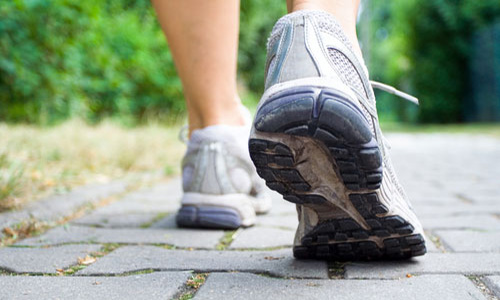Walking is one of the most important and popular forms of endurance exercise. For most people, walking is a safe, easy and no-cost way to be fit.
Research shows that regular, brisk walking has these benefits:
- Improves circulation and helps heart and lungs work more efficiently.
- Lowers blood pressure.
- Improves mood. Eases tension, stress, and anger.
- Allows for time to think and reflect — or to not think and just clear your mind.
- Boosts energy and increases endurance so activities like climbing stairs are easier.
- Gives some protection against osteoporosis.
Walking for fitness is more than a leisurely stroll around the block, although that’s a good place to start if you’re not used to being active. When you walk for fitness, move at a steady pace that is brisk enough to make your heart beat faster and causes you to breathe more deeply.
These tips will help you develop a good walking style:
- Keep your head erect, back straight and let your arms swing loosely at your sides.
- Stay relaxed, breathe deeply and take comfortable steps.
- Always land on your heel and roll forward, finally pushing off the ball of your foot. Walking flat-footed or on the balls of your feet may cause fatigue or soreness.
- Your toes should point straight ahead. “Toeing-in” and “toeing-out” are inefficient ways of walking and may aggravate or contribute to leg/hip joint problems.
Questions about how far, how fast and how often you should walk can be answered by listening to your body. No one can tell you exactly how far or how fast to walk at the start, but you can determine the proper pace and distance by experimenting. If you’ve been inactive for a long time, it will take time to get into shape. Build up slowly. Try to set goals — otherwise, you will be tempted to push yourself too far, too quickly and walking will cease to be enjoyable. Here are some guidelines for establishing your walking routine.
- How far? You may want to start by walking for just a few minutes and gradually increase the time. A good target is to walk for at least 30 minutes — the amount of time it takes to have real fitness benefits.
- How fast? The speed at which you walk is less important than the time you devote to it, although it is recommended that you walk as briskly as your condition permits. The talk test can help you find the right pace. You should be able to carry on a conversation while walking. If you are too breathless to talk, you are going too fast. When walking, should you develop dizziness, pain, nausea or other unusual symptoms, slow down or stop. If your problem continues, see your doctor before walking again.
- How often? Regularity is the key. To be effective, most authorities agree that you should exercise at least three times a week, preferably on alternate days. Fitness is like sunshine; it cannot be stored.
- Be sure to warm up and cool down. This can be as simple as taking the first and last few minutes of your walk at a slower pace. Stretching the Achilles tendon should be part of your cool down to prevent foot problems.
- A good pair of walking shoes is also important to prevent foot, ankle and leg injury. Reserve your walking shoes for just this activity and replace them before they wear out. Shoe wear-and-tear varies from person to person but expect to replace your walking shoes about every six months.







